Disclaimer: As an Amazon Associate I earn from qualifying purchases. Therefore, we may collect a share of sales from the links on this page, at no extra cost to you!
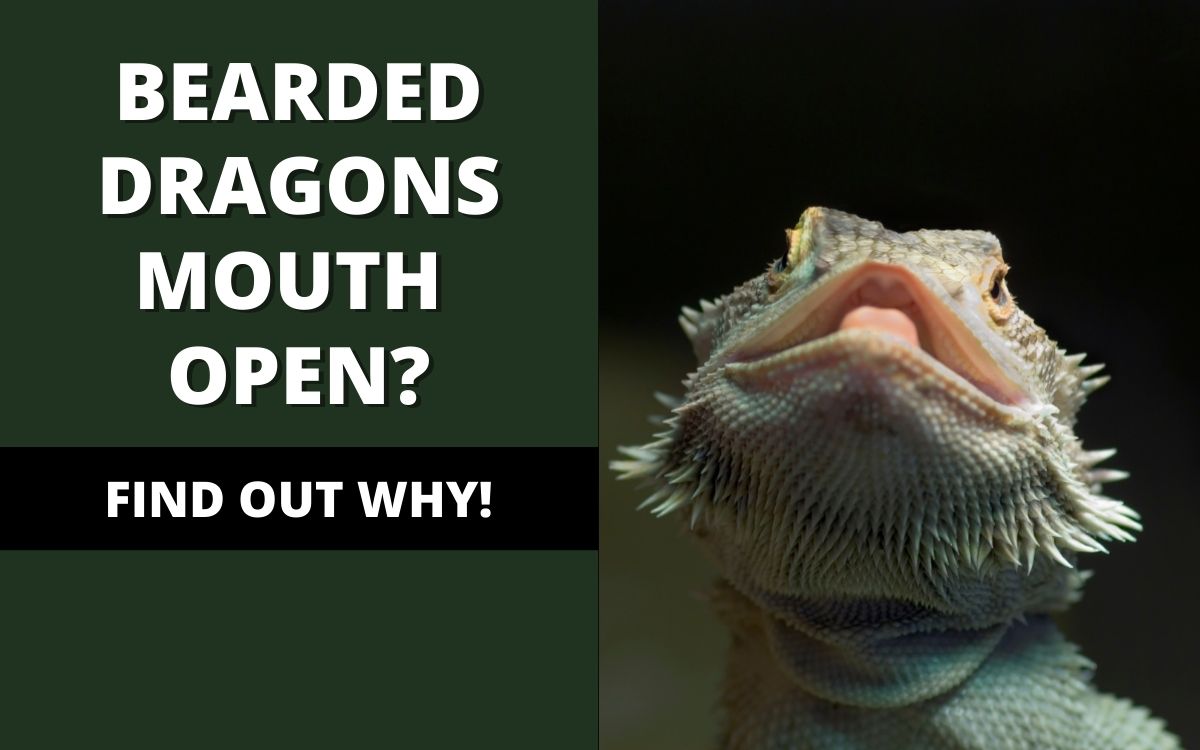
Is Your Bearded Dragons Mouth Open? Find Out Why!
As a bearded dragon owner, you may be familiar with this sight: your bearded dragon, mouth open, looking either completely at peace with the world or confused and uncertain.
Every bearded dragon will, now and then, open their mouth, and keep it open. Nothing about this behavior is unusual and, because of this, you usually don’t have anything to worry about if you see your bearded dragon with its mouth wide open.
Even though this is not an unusual bearded dragon behavior, knowing why this is the case will make caring for your bearded dragon much easier. Your bearded dragon keeps their mouth open for a variety of different reasons and, by being aware of these reasons, you will be able to understand what your bearded dragon is doing and what they need.
By reading through this guide, you will learn the five most common reasons why bearded dragons keep their mouths open. Along with that, you will learn, when applicable, how to change or prevent the conditions that cause your bearded dragon to do that.
Jump to...
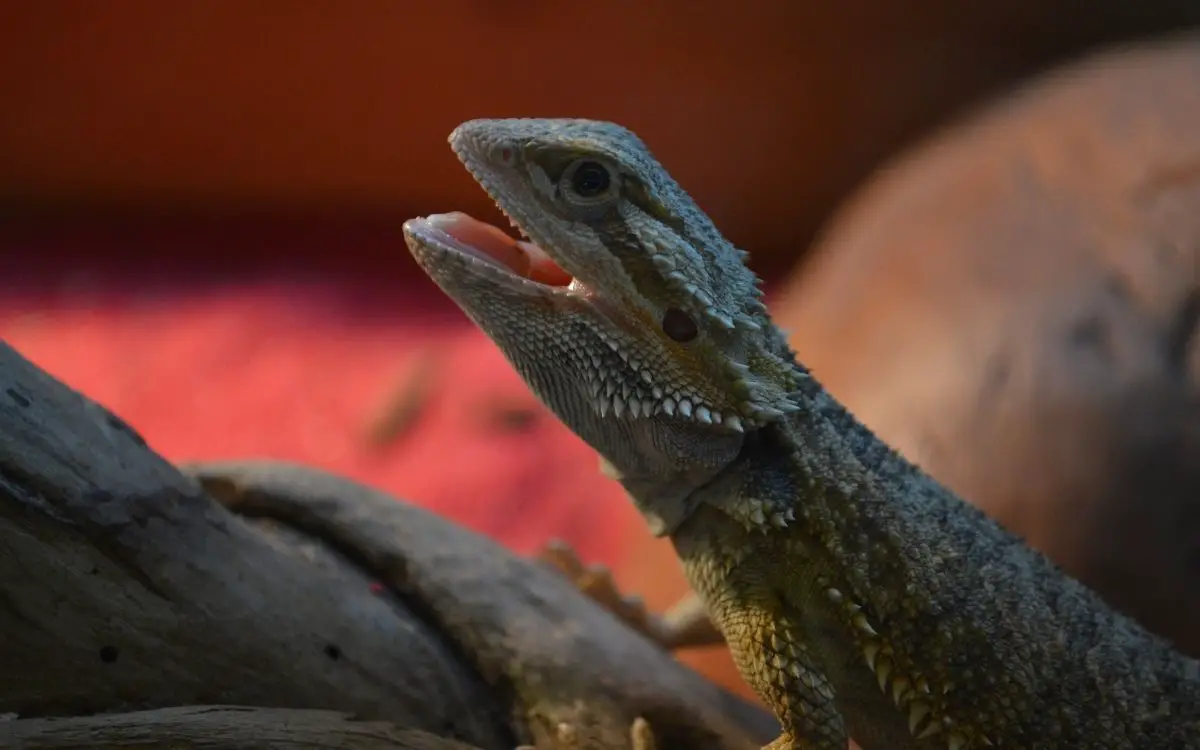
Top 5 Reasons: Why Bearded Dragons Keep Their Mouths Open
No matter what, your bearded dragon will, at random points throughout the day, open their mouth and keep it open. You are about to learn the five most common reasons for this.
Some of these reasons are perfectly normal and require no further action. Some of these reasons, however, are not normal and will require you to take a few actions, so that you can alleviate the problems your bearded dragon is dealing with.
Reason 01: Your Bearded Dragon Is Trying to Regulate Their Temperature
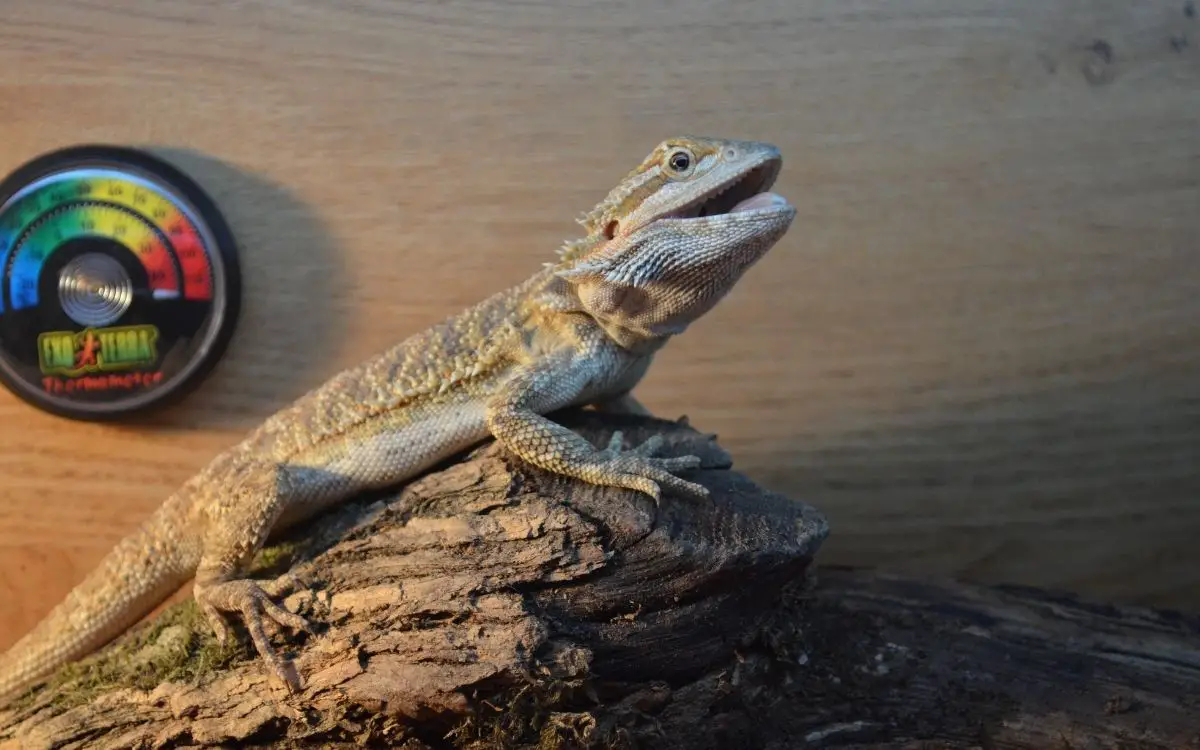
Every animal has a way of regulating its temperature. Cats, for example, pant to cool themselves down and regulate their warmth, and human beings sweat to cool ourselves down.
Bearded dragons are no different. To regulate their temperature, and keep themselves cool, bearded dragons “gape”. Gaping is just what it sounds like: your bearded dragon opens their mouth with their tongue out until they’ve cooled themselves down.
Every time your bearded dragon becomes too warm, they will open their mouth. By opening their mouth, they’re able to prevent themselves from getting any warmer. That way, they can regulate their temperature and keep themselves comfortable.
More often than not, your bearded dragon will gape while sitting underneath the heat lamp in its enclosure. Every time your bearded dragon sits underneath that heat lamp, they are “basking” – warming themselves – and sometimes your bearded will become so warm that they need to cool themselves down before moving. This is a completely normal behavior that, as a bearded dragon owner, you will see quite often.
What isn’t normal, however, is when your bearded dragon gapes while sitting away from the heat lamp. When this happens, your bearded dragon is usually responding to the temperature of its enclosure, which is too warm.
To prevent this from happening, you will need to closely regulate the temperatures within your bearded dragons enclosure. Make sure there are at least two temperature zones, within the enclosure. One of these temperature zones should be a “basking zone”, and the other should be a “cool zone”.
By having two temperature zones within your bearded dragon’s enclosure, your bearded dragon will never be too warm or too cold. Anytime they feel too warm, they can go to the cool zone, and anytime they feel too cold, they can go to the basking zone.
The exact temperature these zones should be set at will depend on the specific recommendations your vet has given you. As a general guideline, though, the basking zone should be set at anywhere from 95-degrees Fahrenheit to 100-degrees Fahrenheit, and the cool zone should be set at anywhere from 75-degrees Fahrenheit to 80-degrees Fahrenheit.
To set up these temperature zones, you will need the proper equipment. The proper equipment, generally speaking, consists of a heating dome, a bulb used for heating, a thermometer, and a timer that allows you to regulate when your bearded dragons enclosure’s basking light is on and off. All of this equipment makes it so much easier to regulate the temperature in your bearded dragons enclosure, so that they are never too hot or too cold.
Also, keep in mind, bearded dragons will sometimes gape during brumation in order to conserve energy.
Reason 02: Your Bearded Dragon Feels Threatened
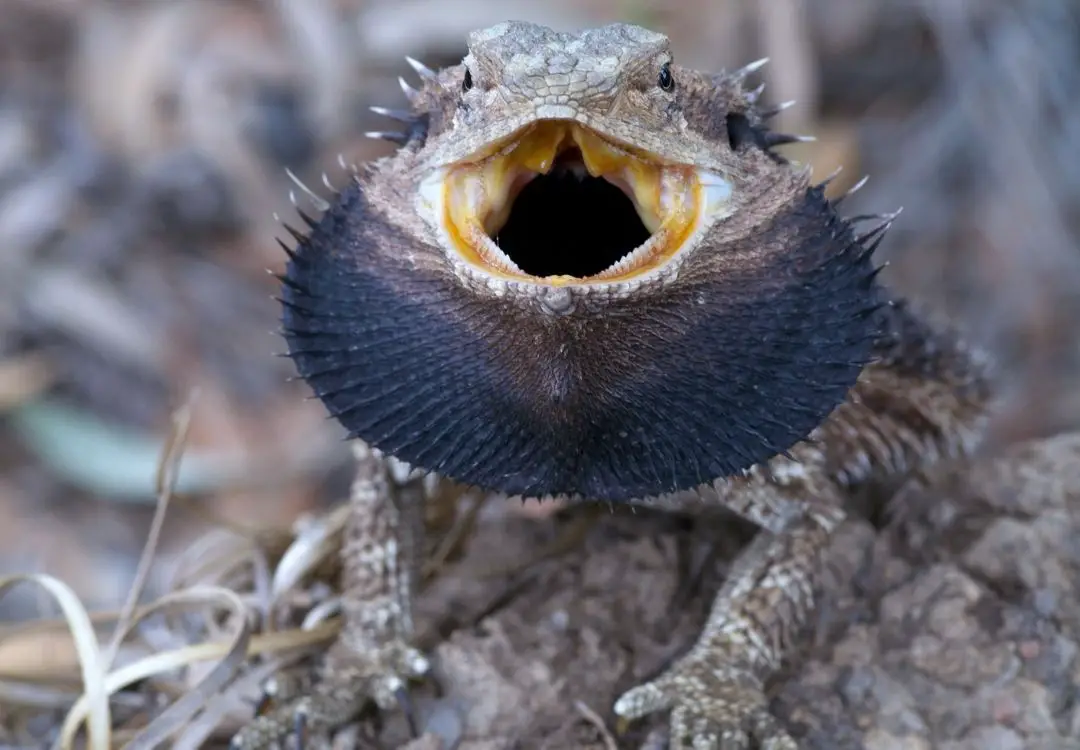
More often than not, bearded dragons are calm, patient, and content. Displays of anger and aggression are rare. But, just because bearded dragons rarely display anger and aggression, doesn’t mean they never do.
A bearded dragon will, when confronted with something that evokes fear or anger, respond in a few ways. Some of the more common responses include standing up tall, hissing at the perceived threat, and bobbing their head at a quick pace. However, there is one other, slightly less common, response that a bearded dragon may display: a big, wide, open mouth.
To tell if your bearded dragon is opening their mouth, due to feelings of fear or anger, there are a couple of things you should look for.
The most important thing to look for is, of course, whether or not there’s anything that your bearded dragon may feel threatened by. A dog, for example, is much larger than a bearded dragon and, if close to your bearded dragon’s enclosure, may be very threatening. Your bearded dragon may also feel threatened by the other pets in your home.
Sometimes, you may not be able to notice anything that looks like a threat. When this happens, it can be hard to tell if your bearded dragon is afraid or not.
If this is the case, you should take a look at your bearded dragon’s body language. A bearded dragon that opens its mouth, as a response to fear, will often stand tall, puff up their chest, and elevate their beard so that it’s right above their puffed up chest.
Seeing any of those signs usually means that your bearded dragon is feeling threatened and is attempting to intimidate whatever it is that they perceive as a threat. But, if those sign’s aren’t present, your bearded dragon may not be feeling fearful or aggressive.
Anytime your bearded dragon is feeling especially fearful and aggressive, they will not respond well to being picked up. Picking up your bearded dragon will, in these instances, likely aggravate them even more, to the point where they may bite you.
Rather than picking up your bearded dragon, you should move the perceived threat away from the bearded dragon. A cat, for example, should be moved away from the enclosure and away from your bearded dragon’s line of sight. Once the threat is out of the way, your bearded dragon will begin to relax and, as they do so, close their mouth.
To prevent your bearded dragon from feeling scared and threatened, make sure to keep what they perceived as a threat away from them and their enclosure. Pets that threaten your bearded dragon, should be kept away from your bearded dragon as often as possible. Too much stress is unhealthy for bearded dragons.
Related: Read these 3 little-known dental tips that will keep your bearded dragons teeth clean and avoid disease
Reason 03: Your Bearded Dragon Is Stretching
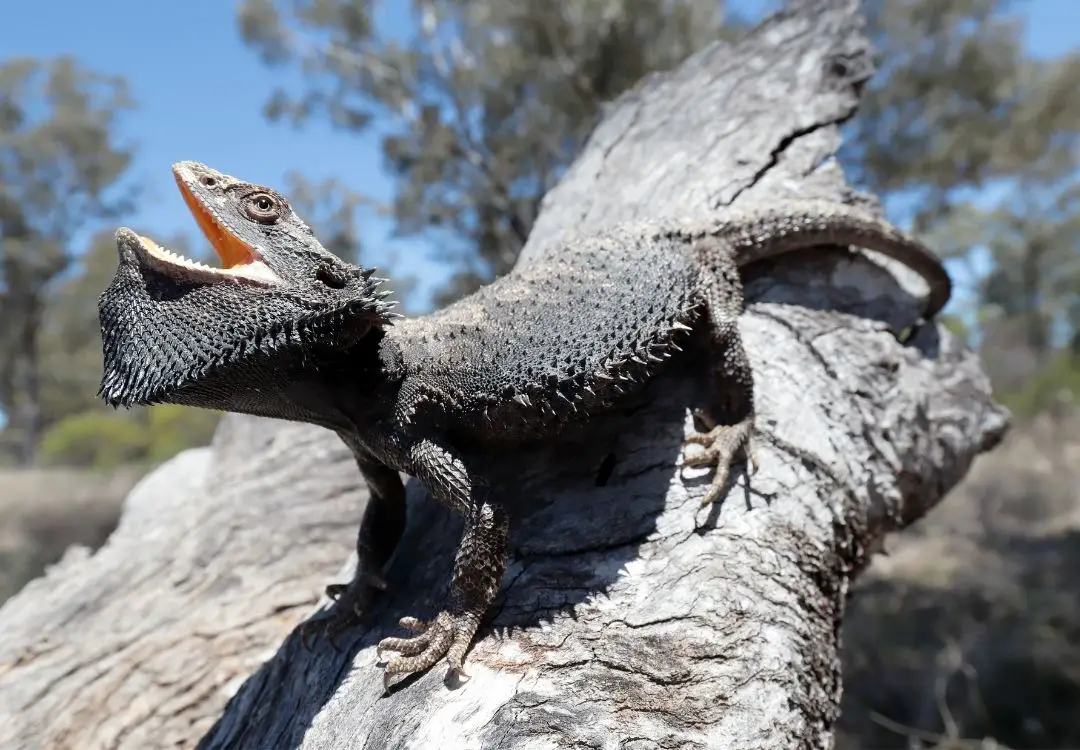
Every bearded dragon will, on a regular basis, need to stretch the muscles in its beard. To do this, a bearded dragon will keep its mouth open for at least a few seconds. Anytime a bearded dragon keeps its mouth open, the muscles within its beard stretch out. Doing this allows those muscles, and the beard, to remain strong and flexible.
At certain points during the year, you may notice your bearded dragon holding its mouth open more frequently. Unless they are doing so for one of the other reasons in this guide, this usually means they’re about to shed and want to loosen up the skin around their beard.
To figure out if this is the case, see if they’re beard is puffed up or not. Most bearded dragons prepare to shed by puffing up their beard, since this makes it easier for the loose skin that sits around the head and beard to fall away.
Since beard stretching is normal, there isn’t anything you need to do. But, to make things easier for your bearded dragon, you can give them a nice, warm bath. Make sure to be with your bearded dragon, as they’re bathing, so that they feel safe and comfortable. After your bearded dragon is finished bathing, the skin on their body will be much looser, making it a lot easier for them to shed all of that skin off.
Reason 04: Your Bearded Dragon Has A Respiratory Infection
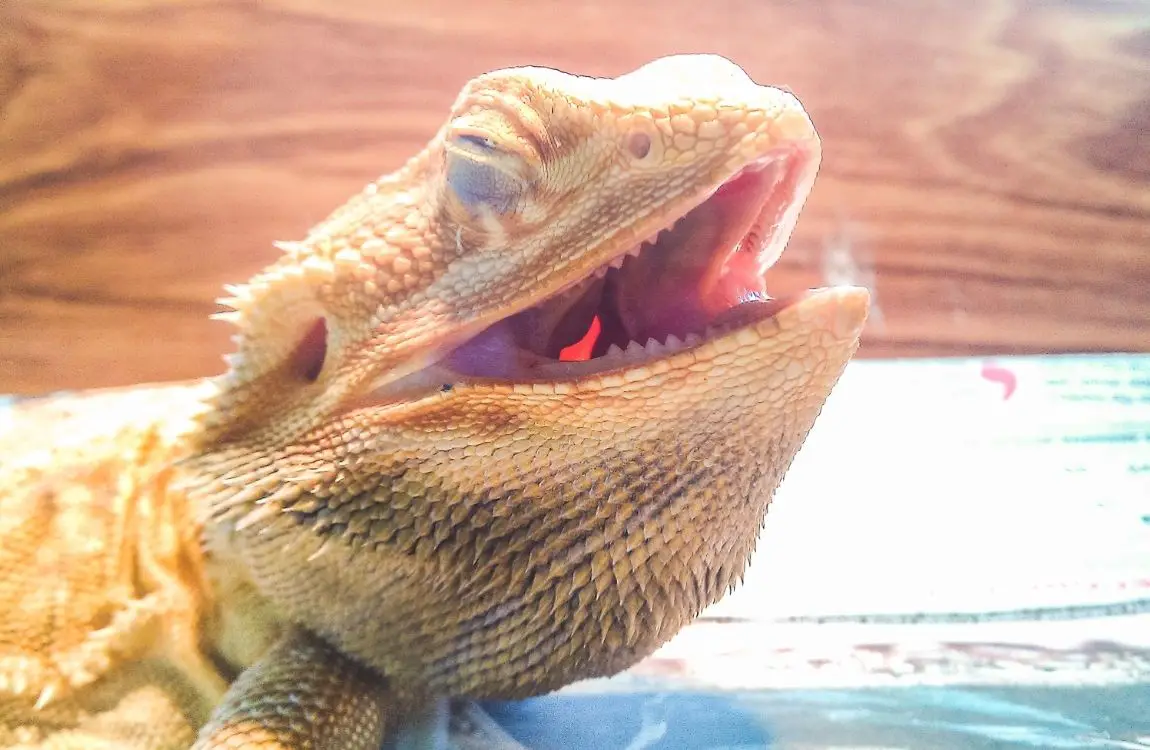
The bearded dragon lizard species comes from Australia. Most bearded dragons have, historically, lived in the subtropical woodlands, scrublands, deserts, and savannas scattered all across the continent.
None of those places is cold and wet. Rather, they are all warm and dry, and that’s the type of climate bearded dragons have evolved to live in.
Since this is the case, bearded dragons are not used to environments with cold temperatures and high levels of humidity. But, not only are they unused to environments of that sort, they aren’t meant to live in them, due to evolving in a warm and dry climate. For a bearded dragon, living in a cold environment with high humidity is uncomfortable and unnatural.
A bearded dragon that spends too much time in a cold and humid environment can easily develop a respiratory infection. Respiratory infections directly affect your bearded dragon’s respiratory system, which makes it a lot more difficult for your bearded dragon to breathe.
When a bearded dragon has a respiratory infection, it is not uncommon for them to open their mouth, and keep it open, for prolonged periods of time. With a respiratory infection, breathing is very difficult, and your bearded dragon will open its mouth as an attempt to more easily breathe in and out.
Respiratory infections are the result of your bearded dragon spending a prolonged period of time in an environment with more than 40% humidity. Since bearded dragons evolved in environments with dry air, they are not used to humid air and breathing it in is difficult and uncomfortable. Spending too much time in an environment with humid air – the exact amount of time depends on the bearded dragon – will cause a respiratory infection to develop.
To treat your bearded dragon’s respiratory infection, the best thing you can do is to take them to the vet. A vet will be able to assess your bearded dragon’s current state, while also determining the next best steps for treatment.
To prevent your bearded dragon from coming down with a respiratory infection, there are a couple of different actions that you can, and should, take. Taking these actions will keep your bearded dragon healthy and comfortable, while also greatly lowering the risk of a respiratory infection developing.
The most important action you must take is keeping the humidity in your bearded dragon’s enclosure no higher than 40%. Anything higher than 40% will be very uncomfortable for your bearded dragon and, as a result, can easily lead to a respiratory infection.
For you to do this, it is worth purchasing a hygrometer and using it to determine the current humidity levels within your bearded dragon’s enclosure. You can glance at this hygrometer, at any time, and you will be able to see the current humidity levels. That way, you always know just how humid it is inside your bearded dragon’s enclosure.
If the humidity levels within your bearded dragon’s enclosure are too high, then you need to reduce those humidity levels. The easiest way to do this is by using a dehumidifier. A good dehumidifier will let you set the humidity percentage you are targeting – in this case, no less than 20% and no higher than 40% – so that every drop of excess humidity is removed.
To further reduce the humidity within your bearded dragon’s enclosure, it is worth doing a deep clean every three-months. Make sure to remove any moss or mold that may have formed on or around the closure.
Beyond that, it is worth keeping your bearded dragon’s water bowl – if you use one – away from the heat lamp. A water bowl that’s too close to the heat lamp will evaporate, which will cause the humidity levels to rise.
Reason 05: Your Bearded Dragon Is Attempting to Dominate Another Bearded Dragon
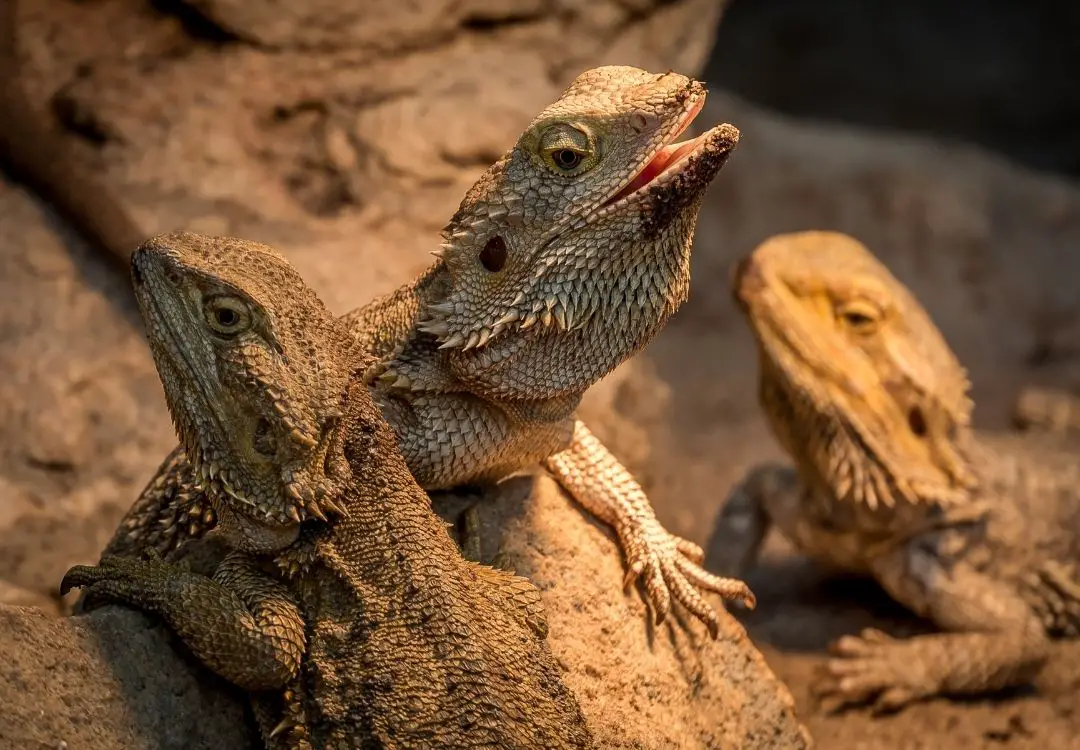
Bearded dragons are solitary reptiles that prefer being alone in their own space. Anytime two bearded dragons are forced to share the same space with one another, one of those bearded dragons will attempt to dominate the other.
To dominate the other bearded dragon, a bearded dragon may open its mouth, and keep it open, while staring at the other bearded dragon. As they do so, they may also puff out their chest and, if the less-dominant bearded dragon gets too close, hiss. By doing this, the bearded dragon is attempting to show the other bearded dragon that they’re the alpha and that the enclosure, and everything inside of it, is their territory.
The dominant bearded dragon will often guard certain areas of the enclosure from the other bearded dragon. Some of these areas may include the water bowl, a hiding spot, and even the basking spot. A bearded dragon that is unable to enter these areas, or is simply too afraid to do so, will be unable to fulfill its basic needs. If these basic needs are unmet for too long, then the less-dominant bearded dragon will suffer from serious health complications, due to being unable to fulfill its basic needs..
The easiest way to prevent this is by giving every bearded dragon that you own a personal enclosure. Two bearded dragons sharing the same enclosure is not a good idea and will always lead to one bearded dragon attempting to dominate the other.
Even if your bearded dragons have their own enclosures, if these enclosures are in the same room, one of them may still attempt to dominate the other by staring at them with their mouth open from its own enclosure. Because of this, keeping your bearded dragons in different rooms is often a wise choice.
Final Thoughts
In the end, your bearded dragon will keep its mouth open for a variety of different reasons. The five reasons outlined in this guide are the five most common reasons for this behavior. There are a number of other reasons, of course, but if your bearded dragon is opening its mouth at random points during the day, it’s likely due to one of the five reasons outlined above.
To figure out the exact reason why your bearded dragon is keeping its mouth open, pay attention to what your bearded dragon is doing and what’s around it. Taking notice of those two things will enable you to figure out why that behavior is taking place. Then, when applicable, you can use the information in this guide to figure out what you need to do to alleviate the conditions causing your bearded dragon to keep its mouth open.
